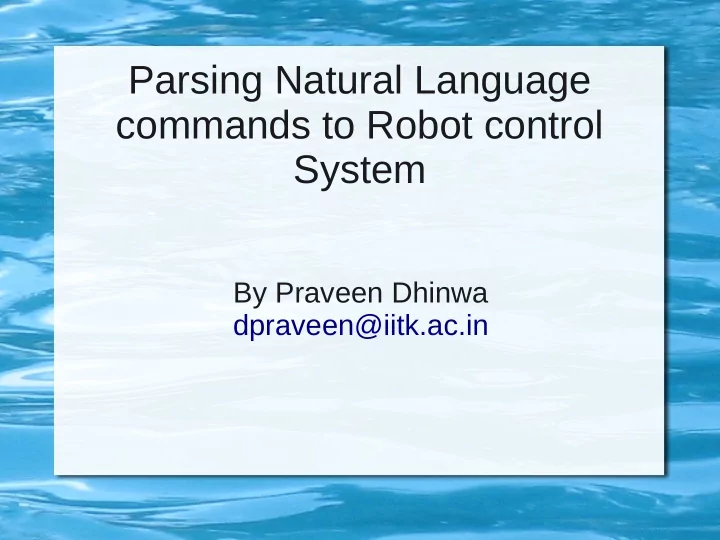

Parsing Natural Language commands to Robot control System By Praveen Dhinwa dpraveen@iitk.ac.in
Objective ● Convert natural language instructions into RCL. ● Language will be Hindi ● Grid navigation system. ● To analyze the success rate of the parser.
Previous Work ● By chen and money [6] ● By Shimizu and Hass [7].
Robot Control Language (RCL) ● Locations : room , junction , hallways ● Movement : move to , turn left / right ● Logic: and / or ● Loops : while , do n times , repeat until ● Verify ● Do sequentially
Example sequentially ● Go left to the end of the hall Go left to the end of the hall.” (do sequentially (turn left (do until (or (not (exists forward loc)) (room forward loc) (move to forward loc)))
Parsing ● UBL (unification based learner) ● A probabilistic model of CCG ● CCG (combinatory categorical grammar) ● <xi , yi> ● where xi : natural language ● And yi : corresponding semantic language sentence.
Softwares to be used ● KRISP (open source) for natural language parsing ● This converts languages strings into CFG ( context free grammar) ● GridSim (for grid simulator)
Example ● Go to the second junction. ● S/NP NP/NP NP/N ● (move-to-forward) (null) (do n times 2x) ● Finally do-seq(do-n-times 2 until junction current loc))
Data sets and maps ● Maps would be created by a grid navigation software (GridSim). ● S_base = 150 sentences(30 pariticipants) ● S_enriched : 20 complex ones(having avg. 4 or more NL instructions). ● S_test : selecting any 10(including atleast 4 complex NL) and their combinations. ● S_training = S_enriched – S_base
Success Rate ● Success rate of [1] is 49 % for complex NL instructions. ● And 66 % for simple NL instructions.
References Learning to Parse Natural Language Commands to a Robot Control System Cynthia 1. ● Matuszek, Evan Herbst, Luke Zettlemoyer, Dieter Fox 2. ● Y. Artzi and L.S. Zettlemoyer. Bootstrapping semantic parsers from conversations. In Proc. of the Conf. on Empirical Methods in Natural Language Processing, 2011. 3. ● A. Ferrein and G. Lakemeyer. Logic-based robot control in highly dynamic domains. Robotics and Autonomous Systems, 56(11), 2008. 4. T. Kwiatkowski, L.S. Zettlemoyer, S. Goldwater, and M. Steedman. Inducing ● probabilistic CCG grammars from logical form with higher-order unification. In Proc. of the Conf. On Empirical Methods in Natural Language Processing, 2010. 5 P. Lison and G-J. M. Kruijff. An integrated approach to robust processing of situated spoken dialogue. In Proc. of SRSL 2009, the 2nd Workshop on Semantic Representation of Spoken Language, pages 58–65, Athens, Greece, March 2009. Association for Computational linguistics. ● 5. Luke Zettlemoyer and Yoav Artzi Learning to Recover Meaning from Unannotated Conversational Interactions 6. Learning to Interpret Natural Language Navigation Instructions from Observations ● David L. Chen and Raymond J. Mooney 7. Learning to Follow Navigational Route Instructions Shimizu and Hass ●
– Questions ?
● Learning a lexicon: ● Algorithm: – (e1,p1) …...... (en,pn) where e1 = navigation instruction – Where p1 = navigation plan ● W → (e1 , ….........en) ● Keep taking top k elements and add it to ● Meanings(w).
Recommend
More recommend